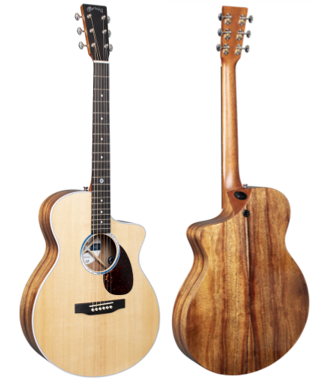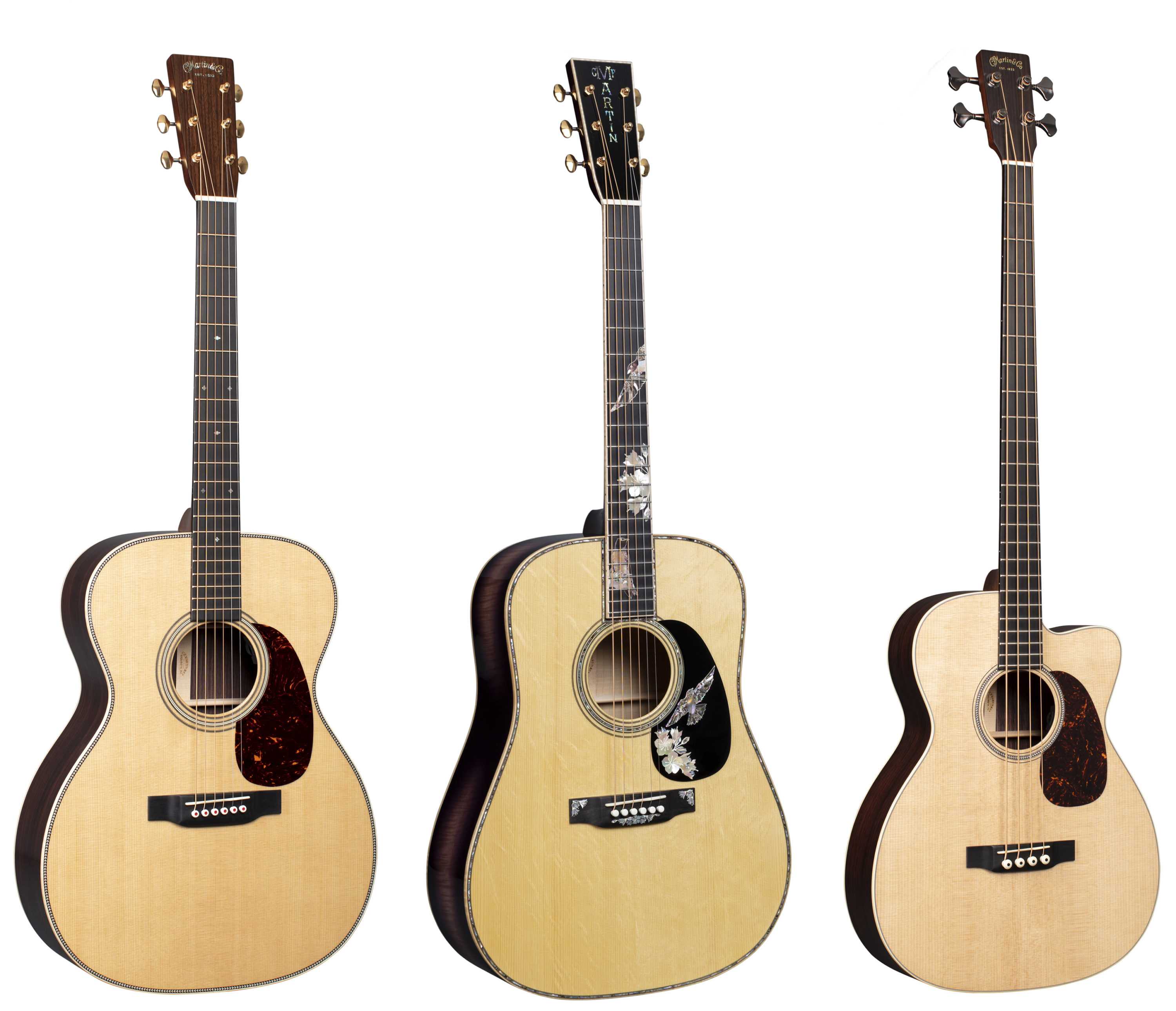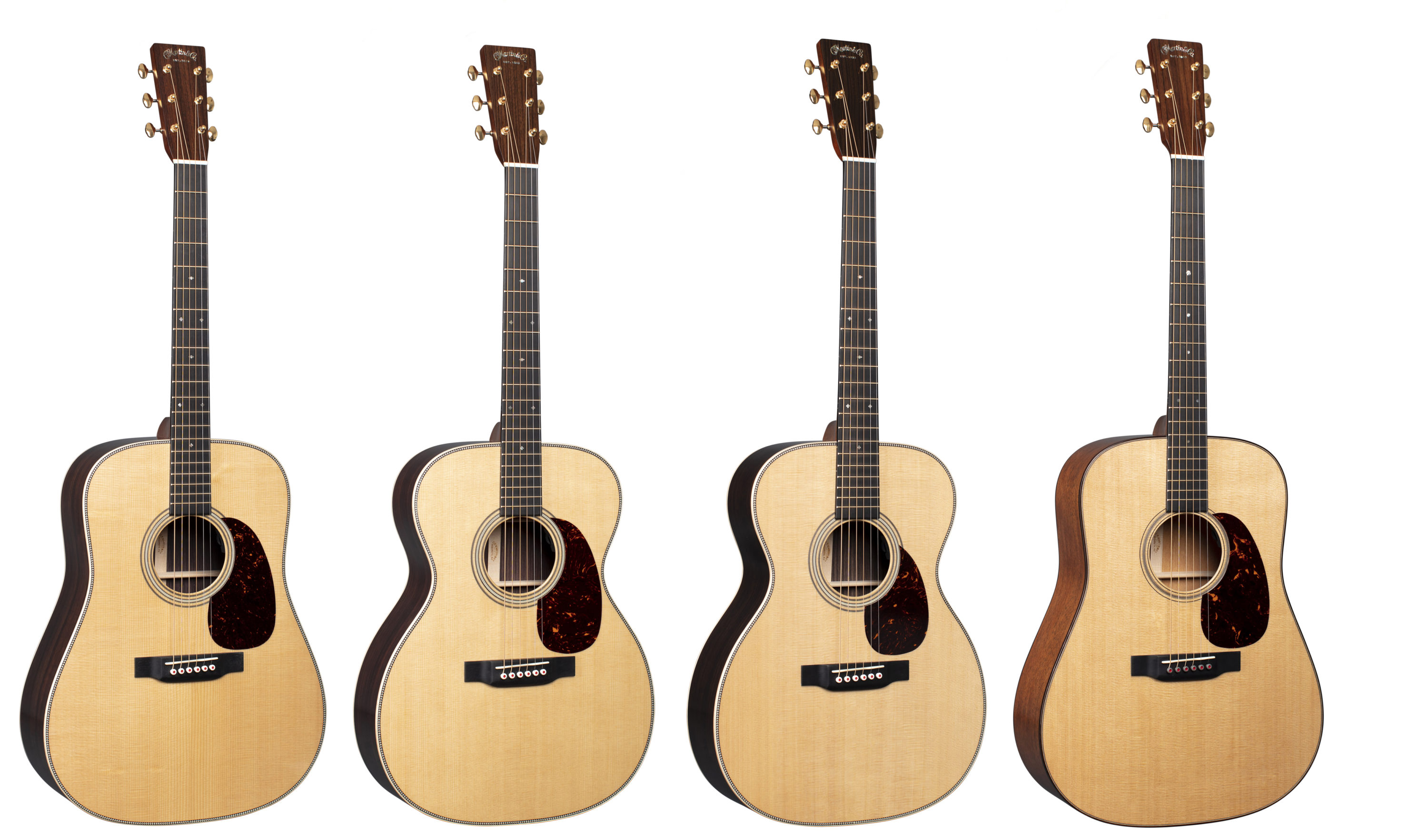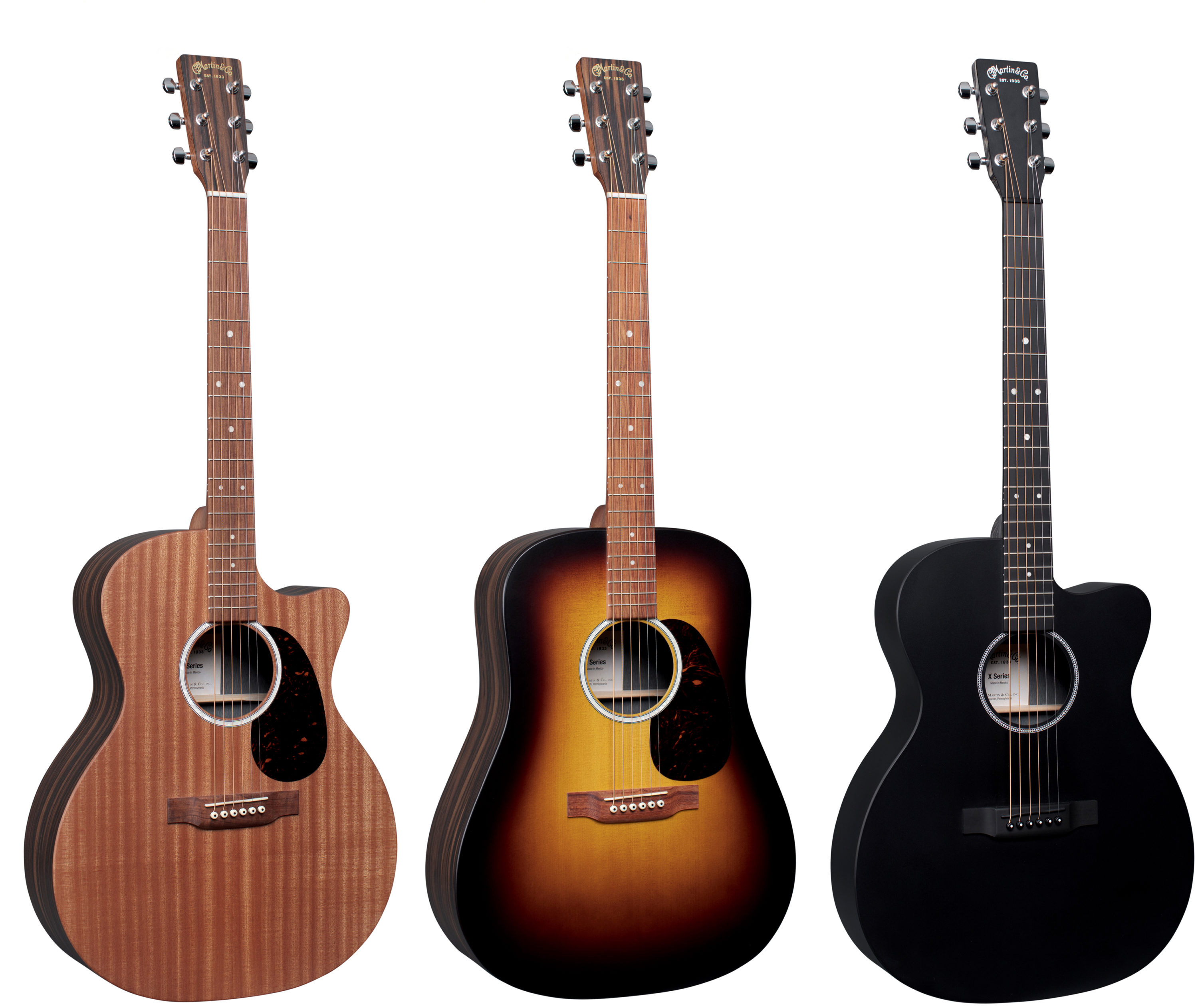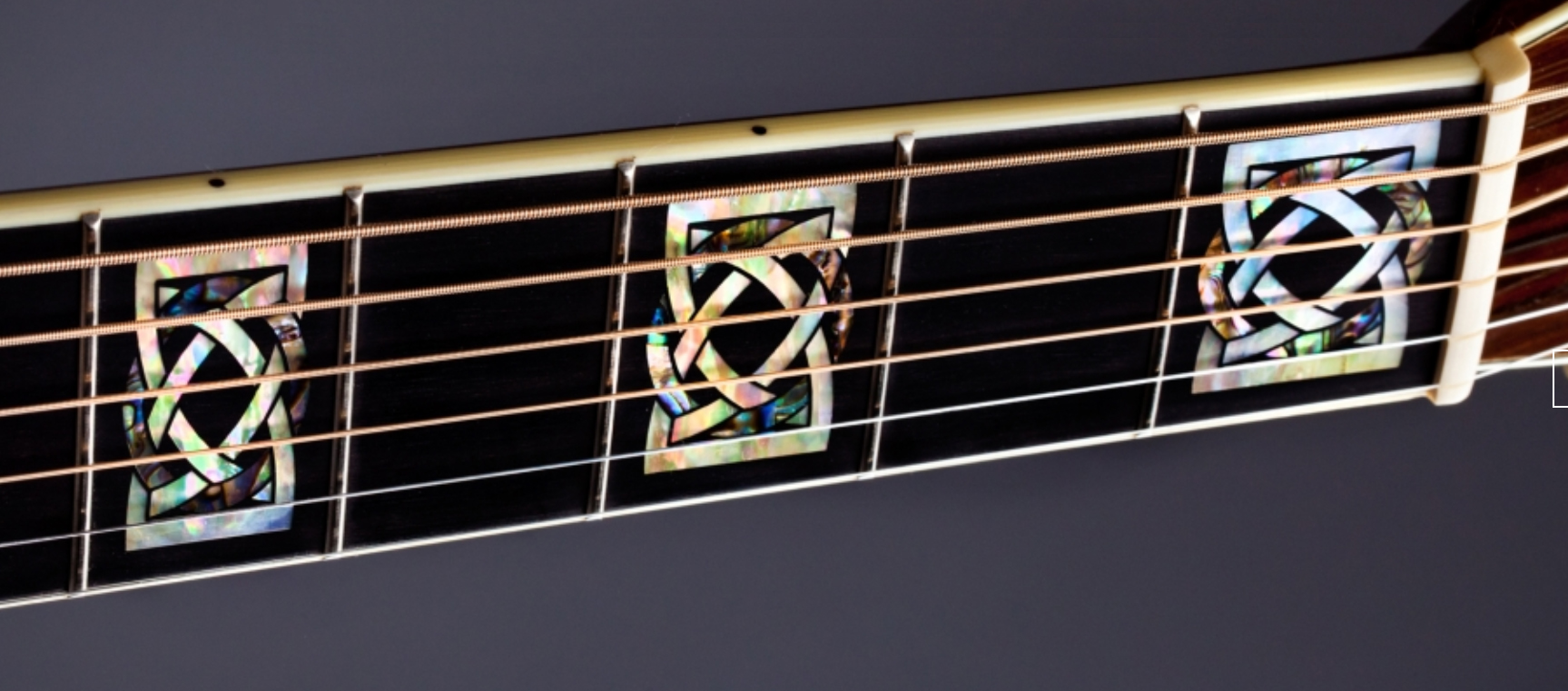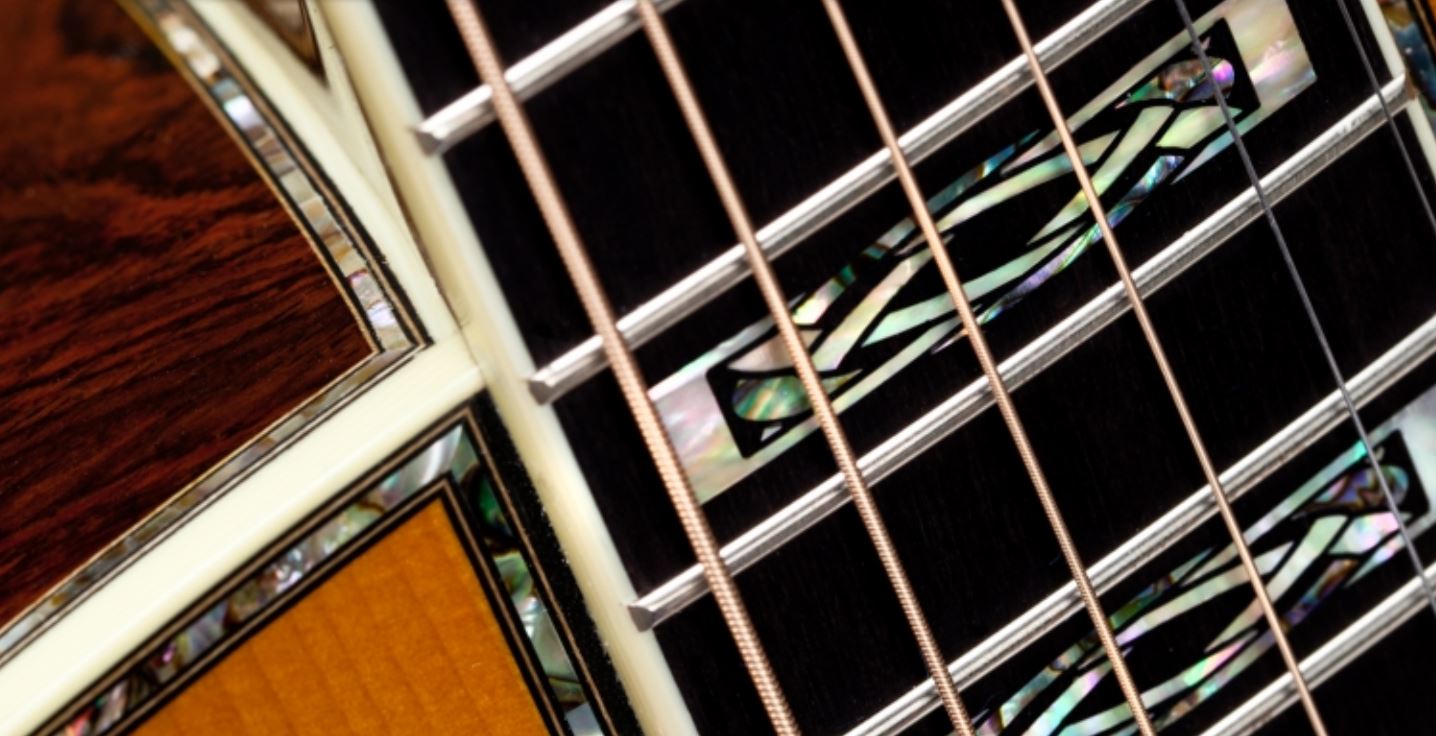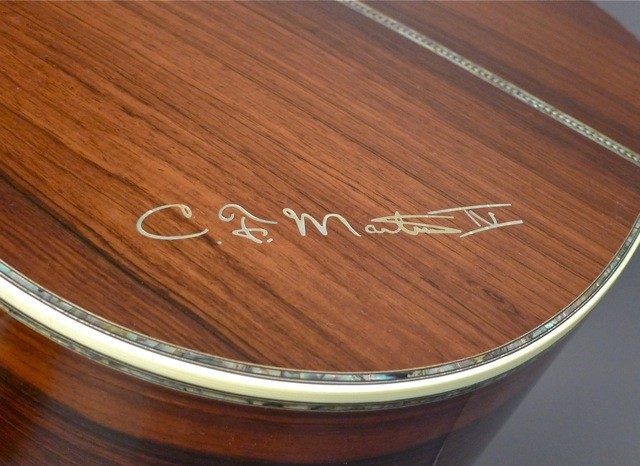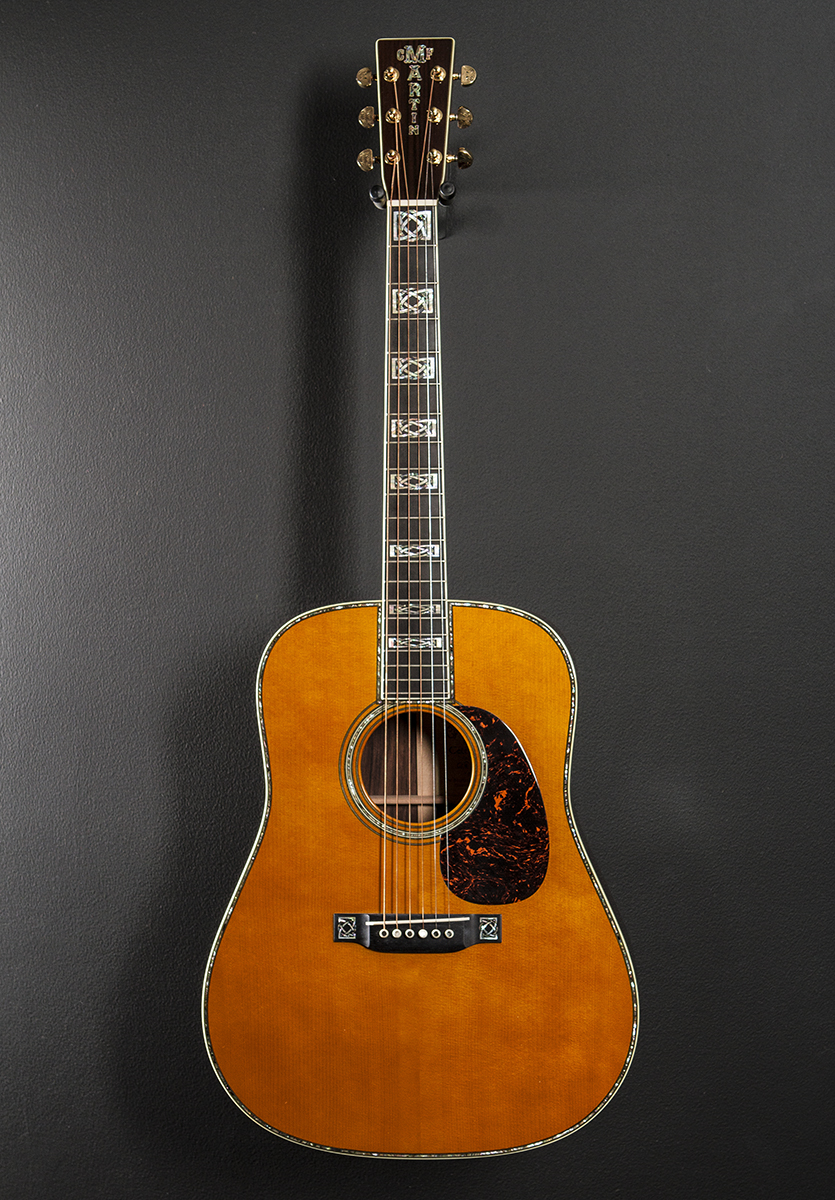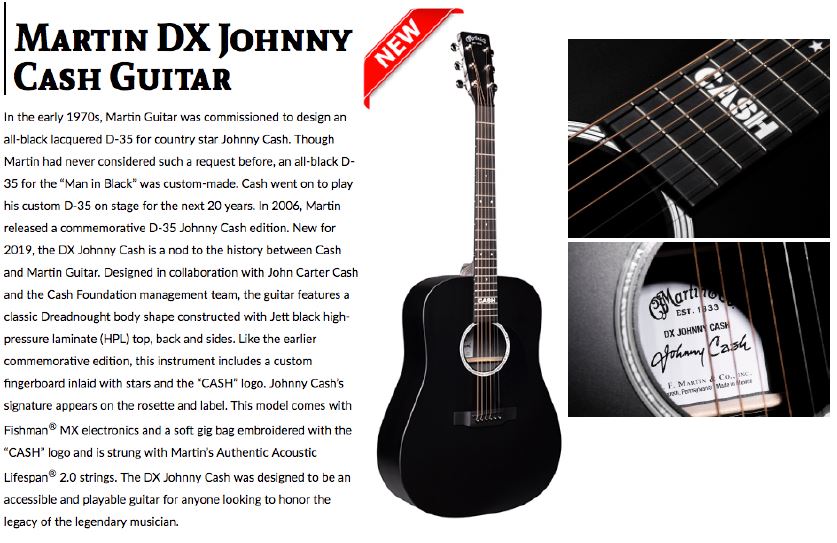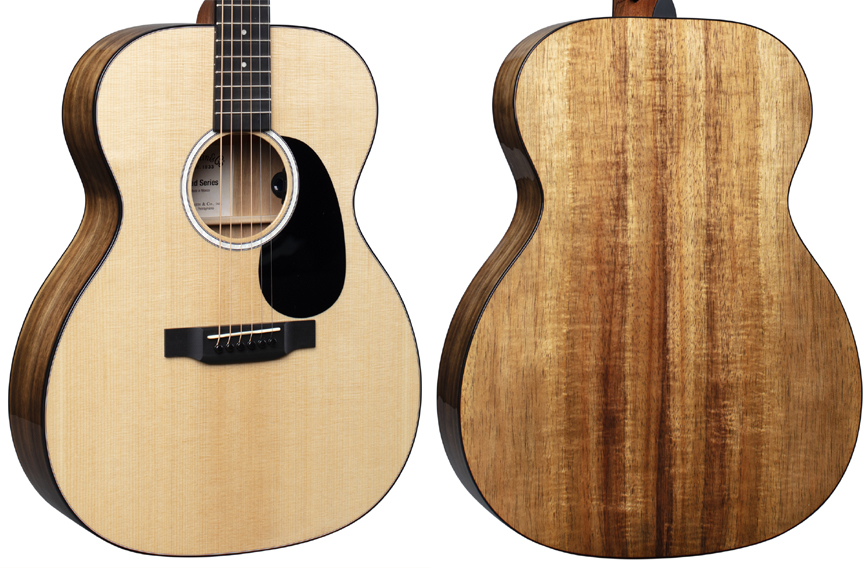Category: Acoustic Guitars
Reviews, essays, and articles relating to acoustic guitars, and related accessories.
Review: Martin SC-13E – Innovative New Design
Martin Wows NAMM with Ultramodern SC-13E
Ergonomic versatility in a beautiful, cutting edge acoustic-electric guitar
January 15, 2020
At three o’clock today, Pacific Standard Time, C. F. Martin & Co. unveiled to the public the SC-13E. With its innovative S size, deep angular Cutaway, and the attractive updated Style 13 appointments, this acoustic-Electric guitar introduces to the world the first new Martin-invented body design since 1934.
SC-13E specs include: New S body size with deep scoop cutaway; fine koa veneer back and sides over solid Khaya core; solid Sitka spruce top; unique asymmetrical bracing with partial scalloping; new heel-less Sure Align neck with new asymmetrical ergonomic Velocity profile; FSC Certified Richlite fingerboard with High Performance Taper; FSC Certified Richlite bridge with 2-5/32” string spacing; newly revised Road Series Style 13 appointments; faux tortoise teardrop pickguard; chrome open back tuners; Fishman XT electronics with onboard tuner.
Note: Specs based on final prototypes, subject to change between now and actual production models.
“Not your granddad’s Martin, the SC-13E is an ultramodern acoustic-electric guitar of tremendous versatility. Its ergonomic design is ideal for long term playing sessions and its innovative shape and bracing provide satisfying tonal balance, good for countless musical styles.”
Bourgeois Guitars Joint Venture with Eastman Guitars
Bourgeois / Eastman Collaboration Update
A Letter from Luthier Dana Bourgeois
“Dear friends,
2019 was an exciting year at Bourgeois Guitars.
The big news, of course, is our recent partnership with Eastman Music. Many are already aware of the particulars. For those who aren’t, following are a few highlights.
I am still an owner of Bourgeois Guitars. I will continue as CEO into the foreseeable future. For the foreseeable future, Bourgeois Guitars will continue making guitars in Lewiston, Maine, and continue distributing our guitars throughout the US. Eastman has already begun distributing Bourgeois guitars internationally, and will eventually handle most overseas sales.
We are pleased that most folks in the acoustic guitar community are already familiar with the details and ramifications of our recent news. We are also aware that misconceptions still exist. The most common misconception is a rumor that association with Eastman will cause American jobs to be exported to China. This couldn’t be further from the truth.
On the contrary, over the next two years we plan to steadily increase our local workforce. Though Eastman’s distribution efforts have just gotten started, overseas sales have quickly risen to the highest level we’ve seen in years. As a result, we are already hiring—not to keep abreast of workforce turnover, but to keep abreast of current and anticipated demand.
In addition, our two-year development plan calls for acquisition of new light and heavy equipment, all to be purchased exclusively from American suppliers. Plans are also underway to expand our Lewiston facility. I can assure you that such developments unambiguously benefit both the local and US economies. I can also assure you that this level of growth would not be possible without Eastman’s collaboration.
The second most common misconception we’ve heard is that the Bourgeois brand will somehow be cheapened or diluted by association with a maker of less expensive instruments. While it is true that brand degradation would likely occur if we tried to fool customers into thinking that guitars manufactured by Eastman were somehow made by Bourgeois, I can aggressively assure you that we won’t. Allow me to explain how we plan to proceed.
The average Bourgeois guitar retails for about $6,000. The cheapest retails for a little under $4,000. While we have always aspired to build quality guitars at lower price points, the economics of micro-scale US manufacturing dictate that we would lose our shirts if we tried.
As previously announced, Bourgeois and Eastman will address this conundrum by collaborating on a new series of guitars that will be partly produced by each company. Bourgeois will be responsible for design, materials selection, production of voiced tops, final setup and quality control; Eastman will assemble and finish guitars to our specifications. Not only will this collaboration further increase job creation in Lewiston, it will also allow us to crack the $4,000 price barrier, and by a significant margin. US introduction, by the way, is scheduled for the latter part of 2020.
While co-produced guitars will carry a Bourgeois headstock logo, they will also be distinguished by an unambiguous Series designation. Most significantly, the label inside each co-produced guitar will clearly credit Eastman’s role in it’s manufacture.
The slogan, “Made in Lewiston, Maine”, heretofore proudly displayed on all Bourgeois labels, will in the future be reserved only for guitars made entirely in Lewiston, Maine. Guitars made entirely in Lewiston will continue to be built by the same process, to the same designs, and by the same highly skilled craftsman who made them prior to our association with Eastman. The only difference is that we now have access to better equipment, facility and materials, and are already able to provide employees with better benefits. We sincerely believe that under such conditions, the quality of a guitar made in Lewiston should only continue to rise.
Finally, we’ve heard variations on an unfounded rumor that Bourgeois guitars will soon be carried by every US Eastman dealer. Again, not so. While Eastman’s dealership network will undoubtedly help introduce Bourgeois guitars to previously untapped foreign markets, only a few qualified Eastman dealers will be allowed to represent Bourgeois Guitars in the US. Moreover, new dealers will only be opened in markets that do not already support existing Bourgeois dealerships. In short, the Market should expect, as we do, that expansion of our dealership network will continue to be gradual and organic.
Each day I wake up feeling that my best guitars haven’t yet been built. Partnership with Eastman only reinforces that belief. I judge the quality of a guitar primarily by the music it makes in the hands of its player, and by the joy it brings to player and listener like. While alliance with Eastman may put Bourgeois guitars in the hands of more players, the rest is still up to me and my Lewiston, Maine, team. We continue to take that responsibility as seriously as ever.
Please help spread these messages to anyone who has not heard them. Thank you in advance for your continued support.”
Sincerely,
Dana Bourgeois
CEO, Bourgeois Guitars
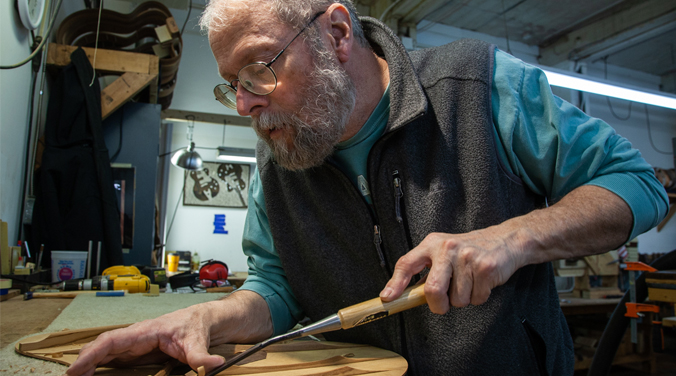
Winter NAMM Martins Revealed
New Martins for a New Decade
Limited Edition D-18E 2020 and the latest, greatest Aura Blend electronics highlight Martin’s Winter NAMM 2020 Offerings
A year ago Martin debuted their Modern Deluxe Series with four new models that employ cutting-edge technologies to create light-weight acoustic guitars that feel and play a lot like vintage Martins, with unique and impressive tone all their own. Today they unveiled the acoustic-electric versions of those same models, the D-28E Modern Deluxe, D-18E Modern Deluxe, OM-28E Modern Deluxe, and 000-28E Modern Deluxe.
I’ve had to keep my trap shut for half a year about the new Hi-Def generation of Fishman’s Aura electronics, ever since the power that is C. F. Martin IV decided to not to release the acoustic-electric versions of the Martin’s Modern Deluxe Series until Winter NAMM 2020.
But now they are out of the bag and I can tell you this is one of the most exciting upgrades in a long while when it comes to live acoustic tone via a plugged-in guitar.
At the heart of the new Aura VT Blend system is the amazing and highly-complex algorithm that is the adjusts in real time to whatever and however a guitarist is playing the instrument, and the proprietary tone-sculpting effects that work together to make the plugged-in tone sound much more like the actual acoustic instrument as heard through a world-class microphone.
Their are two parts to why this new version of the Aura technology is an improvement over the one that is currently in use on other Martin models. First, there is the greater detail and definition to the overall amplified voice. But perhaps best of all, the new Aura Blend system includes the ability to control how much of the Aura filters are applied to the direct signal from the Fishman undersaddle pickup. So, in addition to the VT volume and general tone control, the player blends in the amount of the onboard Aura microphone image they like best, depending upon the sound system, room, or purpose.
It has been a while, so I went looking for my notes from last year and can’t find them. So, I returned to the source, and asked Tim Teel, Instrument Design Manager at C. F. Martin & Co., what is his current take on the new Modern Deluxe models with the latest, greatest Fishman Aura VT Blend system.
“I thought it was very important to marry this new incredible sounding Aura VT Blend system to what I consider is our best sounding series; Modern Deluxe.
The new Aura VT Blend starting in 2020 on the Modern Deluxe series is the next evolution regrading pro-level sound reinforcement for the acoustic guitar. Full blend control between under-saddle piezo pickup and Aura microphone image has been given back to the player!
In a live setting, 40-60% Aura Image is more than enough, and when plugged directly into a computer for recording, up to 100% of Aura image can be utilized. Also, new for this release is Aura HD Imaging, giving stunning realism to the sound of the guitar when played through an amplifier or direct recording. A volume and multi-effect EQ scoop round out the user controls located conveniently in the sound hole of the guitar.
I encourage folks to give it a test play at their local dealer.
And I shall be testing them out in the now public version next Thursday, on the very day they are released at Winter NAMM.
Here is a quick overview of many of the new Martins debuting next week.
C. F. Martin & Co.® (Martin®) will introduce a suite of upgraded X Series guitars, a new 12-fret nylon string guitar, a new acoustic bass guitar, new 16 Series models, new Modern Deluxe Series models with electronics, a limited edition D-18E 2020, and the fourth in a series of exquisite Purple Martin models at Winter NAMM in Anaheim, California, January 16-19, 2020.
LIMITED EDITIONS
D-18E 2020
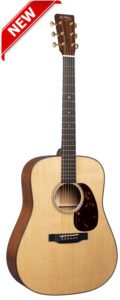 The D-18E 2020 is a limited edition version of the historic 14-fret D-18, which officially joined Martin’s lineup in 1934. Like its namesake, the D-18E 2020 is constructed with a Sitka spruce top and genuine mahogany back and sides plus all of the Standard Series elements that, combined, offer supreme playability and legendary Martin tone. What sets it apart is the use of exquisite East Indian rosewood for the headplate, fingerboard, binding, bridge, and heelcap. The D-18E 2020 comes stage-ready with LR Baggs Anthem electronics. The guitar is strung with Martin Authentic Acoustic Lifespan® 2.0 strings, and it is limited to 2,020 instruments.
The D-18E 2020 is a limited edition version of the historic 14-fret D-18, which officially joined Martin’s lineup in 1934. Like its namesake, the D-18E 2020 is constructed with a Sitka spruce top and genuine mahogany back and sides plus all of the Standard Series elements that, combined, offer supreme playability and legendary Martin tone. What sets it apart is the use of exquisite East Indian rosewood for the headplate, fingerboard, binding, bridge, and heelcap. The D-18E 2020 comes stage-ready with LR Baggs Anthem electronics. The guitar is strung with Martin Authentic Acoustic Lifespan® 2.0 strings, and it is limited to 2,020 instruments.
List price $3,649
D-42 Purple Martin Flamed Myrtle
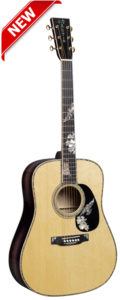 The D-42 Purple Martin Flamed Myrtle is the fourth instrument in the Purple Martin Series. The “Purple Martin” theme is inspired by a native bird of Pennsylvania, where Martin Guitar’s headquarters and factory are located. Limited to 100 instruments, this head-turning model includes 42-style pearl inlay throughout and highly decorative inlay on the fingerboard and pickguard of the purple martin bird and mountain laurel flowers, the state flower of Pennsylvania. It is a full-gloss guitar with a heavy bearclaw Engelmann spruce top with a deep purple burst and stunning flamed myrtle back and sides. Each model includes a label signed by C. F. Martin & Company Chairman and CEO Chris Martin. The D-42 Purple Martin is strung with Martin Authentic Acoustic Lifespan® 2.0 strings.
The D-42 Purple Martin Flamed Myrtle is the fourth instrument in the Purple Martin Series. The “Purple Martin” theme is inspired by a native bird of Pennsylvania, where Martin Guitar’s headquarters and factory are located. Limited to 100 instruments, this head-turning model includes 42-style pearl inlay throughout and highly decorative inlay on the fingerboard and pickguard of the purple martin bird and mountain laurel flowers, the state flower of Pennsylvania. It is a full-gloss guitar with a heavy bearclaw Engelmann spruce top with a deep purple burst and stunning flamed myrtle back and sides. Each model includes a label signed by C. F. Martin & Company Chairman and CEO Chris Martin. The D-42 Purple Martin is strung with Martin Authentic Acoustic Lifespan® 2.0 strings.
List price $14,999
MODERN DELUXE WITH ELECTRONICS
The award-winning Modern Deluxe Series was introduced at Winter NAMM 2019, and Martin has received universal praise for marrying vintage appointments, like a VTS top, and modern upgrades, like a titanium truss rod. This year, Martin has added all-new Fishman® Aura® VT Blend electronics to offer players more control over the voice of the guitar than ever before. It utilizes Aura HD Imaging to provide stunning realism and delivers a new level of performance for direct recording in live situations. The stage-ready Modern Deluxe Series with electronics is offered in four models—the D-28E, 000-28E, OM-28E, and D-18E—and all are strung with Martin Authentic Acoustic Lifespan® 2.0 strings.
List prices range from $4,999 – $5,799
16 SERIES
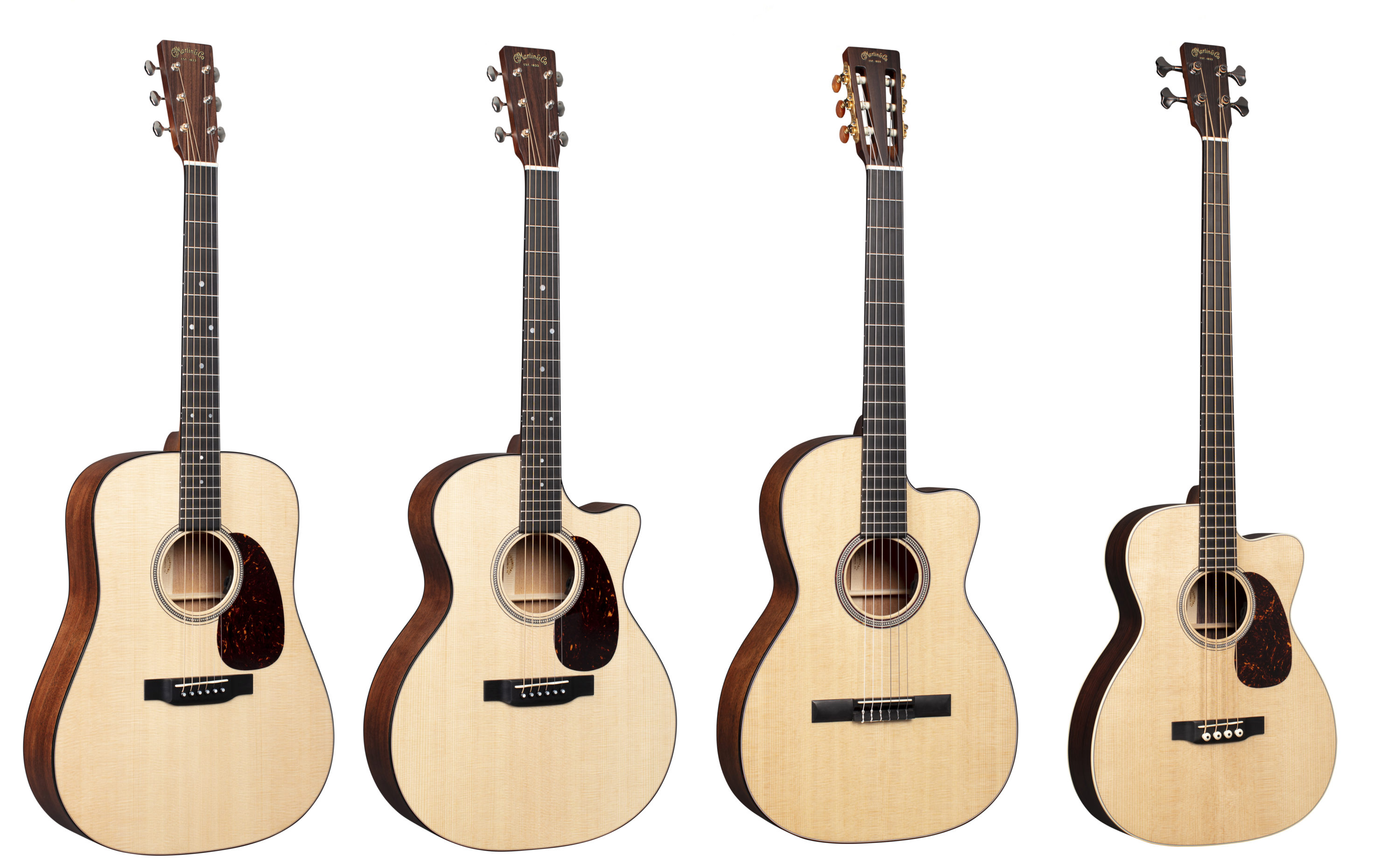
D-16E Mahogany
The Martin D-16E Dreadnought is crafted with satin-finished mahogany back and sides for a big sound, punchy midrange, and bright treble response. It include a Sitka spruce gloss top for balanced tone and projection and a 000 body depth and high-performance neck taper for comfort and ease of playability. It comes equipped with Fishman® Matrix VT Enhance™ electronics and Martin Authentic Acoustic Lifespan® 2.0 strings.
List price $2,049
GPC-16E
The Martin GPC-16E Grand Performance Cutaway is crafted with satin-finished mahogany back and sides for a big sound, punchy midrange, and bright treble response. It includes a Sitka spruce gloss top for balanced tone and projection and a 000 body depth and high-performance neck taper for comfort and ease of playability. It comes equipped with Fishman® Matrix VT Enhance™ electronics and Martin Authentic Acoustic Lifespan® 2.0 strings.
List price $2,049
000C12-16E NYLON
The Martin 000C12-16E Nylon 12-fret guitar is ideal for any classical guitarist looking to take their playing to the next level. This Auditorium-style, six-string guitar features a Sitka spruce gloss top and satin-finished mahogany back and sides for bright treble response and plenty of volume. It comes equipped with Fishman® Matrix VT Enhance™ electronics and is strung with Martin Magnifico® premium classical strings.
List price $2,499
BC-16E
The Martin BC-16E is the ideal tool for the modern bassist’s acoustic or electric needs. The BC-16E includes a solid Sitka spruce top, East Indian rosewood back and sides, and forward-shifted scalloped bracing to deliver deep, thumping Martin tone, whether you’re unplugged or using the built-in Fishman® electronics. It also includes a fast, comfortable neck so you can keep the rhythm section tight. The BC-16E is strung with Martin Authentic Acoustic SP® Bass strings.
List price $2,399
X SERIES
Two decades ago, Martin broke into the world of alternative, sustainable materials and created a whole new class of high-quality guitars called the X Series. Today, with new HPL patterns, scalloped bracing, and a solid wood neck, fingerboard, and bridge, the new X Series guitars look and sound better than ever. Plus, every X Series guitar now comes with a padded, water-resistant gig bag. The new and improved Martin X Series guitars are built to go anywhere, offering beginners and active musicians a carefree playing experience.
Learn more about the MANY new X Series instruments via the links below.
X2 Series
Made with Solid Wood Tops with High Pressure Laminate Backs and Sides
List prices from $799 – $899.
X1 Series
Made with High Pressure Laminate Top, Back, and Sides.
Technical Difficulties
Due to software upgrade glitch at our web hosting service, the address onemanz.com/guitar is to not currently working.
This may take a day or two to resolve.
The site is otherwise online and operational, but the home page is not.
Thank you for your patience.
Moon River Mark by Dick Boak
A Life on Georgian Bay
A singer-songwriter expose
Dick Boak has created a video about a Martin-loving maverick named Mark Groulex, aka Moon River Mark of Ontario, Canada. Moon River runs through the forests near the eastern section of Lake Huron called Georgian Bay, about 200km north of Toronto. Boak first encountered Groulex at a local open mic when vacationing in Canada. The two have remained friend ever since.
What’s the Scéal Iomlán on the Martin D-45 Celtic Knot?
A Reader Requests Info on the Celtic Knot
What a gift of a website you have created. Thank you. I recently purchased a D-45 Celtic Knot. Whatever background information regarding the concept, design and construction of it would be really helpful.
– Robert in Texas
Spoon Replies:
Thank you Robert, for your kind and encouraging words.
Allow me to say meal do naidheachd on the purchase of your Martin D-45 Celtic Knot! It is my personal favorite among all the “45 +” guitars that Martin has come up with over the years.
That’s Scottish Gaelic, by the way. The oldest existing designs known as Celtic knots are found in illuminated Christian manuscripts from the eighth century, associated with the Abbey of Hii on the Isle of Iona, while others dated to 800 A.D. are believed to come from the Abbey of Kells, in County Meath, Ireland. It is assumed that earlier Celtic knot patterns evolved in Eire and Britain, in decorative textiles and other art forms, after similar “continuous cord” designs were introduced from Roman Europe sometime during the fourth century.
Your wonderful twenty-first century Martin guitar is essentially a D-45 Golden Era, in terms of bracing, neck shape, and string spacing. But of course the Brazilian rosewood and Adirondack spruce came from Chris Martin’s personal reserve. As a musical instrument, every one of them I have played sounded spectacular.
As an example of exquisite artistry in world-class luthiery, they are visually astounding as well. The inlay was done at Pearl Works in Charlotte Hall, Maryland, founded by the late Larry Sifel. The inspiration for the overall design came from Martin’s 600,000th guitar, completed in 1997. Known as “the Celtic” Martin, it was designed and embellished by Larry Robinson, who has created stunning inlays for electric and acoustic guitars for half a century.
Although this earlier instrument has even greater complexity to its various “knots” and, if I recall, abalone herringbone purfling around the edge of the top and sound hole, I have always preferred the aesthetic of the D-45 Celtic Knot. It strikes me as elegant and stately, compared to the rather over-the-top pizazz of the Celtic guitar. But I also very much like the special Gotoh tuners with Celtic designs, and the pearl inlay of Chris Martin’s signature on the rosewood back!
The limited edition of fifty D-45 Celtic Knot guitars was announced at Winter NAMM 2004, along with Martin’s One Millionth Guitar and the D-100 model based on it. The Celtic Knot guitars have sequential serial numbers leading up to #1,000,000. The fifty D-100s have sequential serial numbers starting with #1,000,001.
However, Martin did not build all fifty Celtic Knot guitars. There has been some contention as to the actual production number. Although all official printed references claim that thirty D-45 Celtic Knot guitars were built, the actual quantity is in fact thirty-six.
No one knows why the discrepancy exists. I suspect all accounts were based on one original reporting that contained a typo. Knowing how things happen at Martin, it might even be due to a typist incorrectly reading someone’s handwriting, where the 6 looked like a 0.
In any case, you have a very special Martin. If I could have any of the beyond-Style-45-Deluxe instruments Martin has built, it would be a D-45 Celtic Knot. But you actually get to own one.
I therefore, and with great pomp and solemnity, hereby induct you into the Order of the Lucky Dog, with all rights and privileges afforded said title.
Congratulations!
Pearl Works Website:
Larry Robinson Website:
https://www.robinsoninlays.com/
(photo: Pearl Works)
(photo: Pearl Works)
(photo: Dream Guitars)
(photo: Dave’s Guitars)
Fall Martin Models Announced – Woodstock D-45
D-45 Woodstock 50th Anniversary Model Among New Martin Line Up
Hawaiian Koa Showcased in Road Series and X Series
Whatever the reason, C. F. Martin & Co. decided to announce their autumn additions early this year, to coincide with the release of the third and final Woodstock 50th Anniversary guitar.
click on photos to enlarge
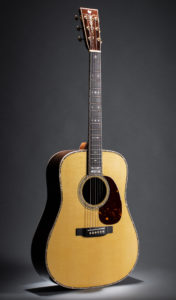 |
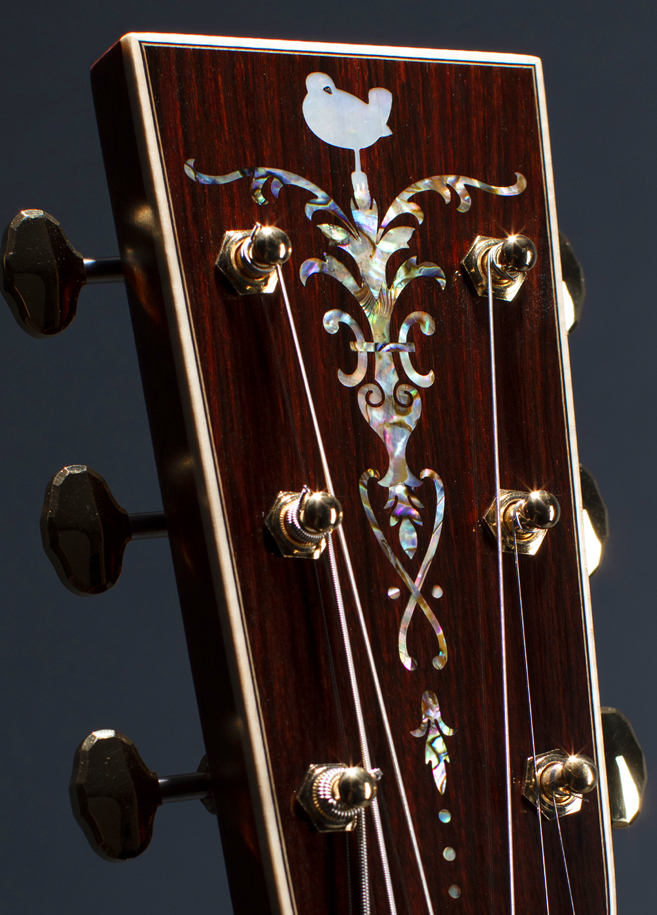 |
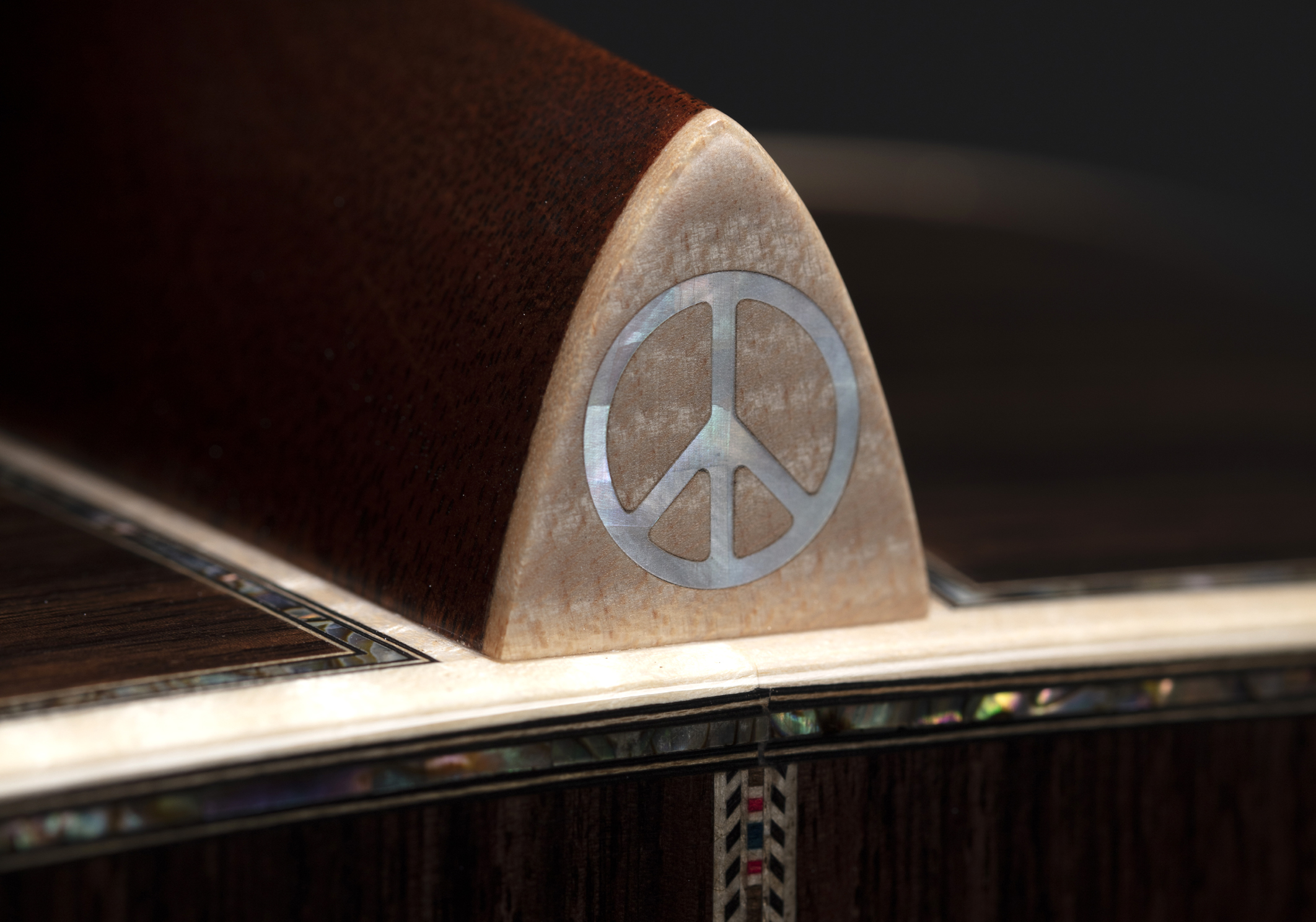 |
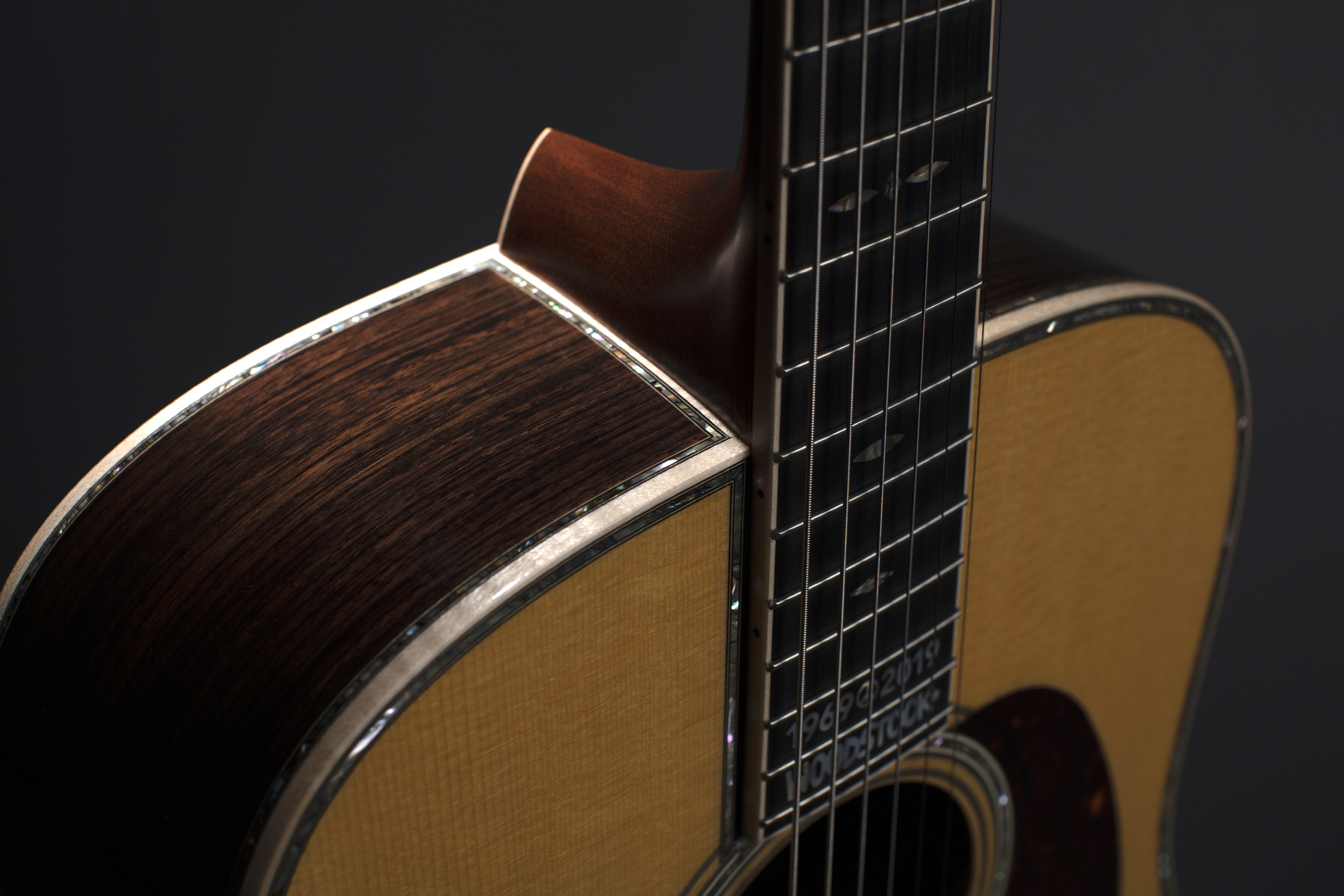 |
Extra Fancy D-45
The Martin D-45 Woodstock 50th model is built from top-grade Indian rosewood and Sitka spruce, European flamed maple binding on the body, the Genuine Mahogany neck with its High Performance ebony fretboard, and around the front of the headstock. It also has the forward-shifted scalloped braces and Modified Low Oval neck profile of the Standard Series D-45.
The headstock features an inlay of the iconic Woodstock dove, sitting atop Martin’s ornate Alternate Torch inlay, made of high color abalone pearl, as are the 1930s style Snowflake fretboard markers, and of course the purfling inlaid around the sound hole, and every edge of the top, sides, and back, including the edge where the neck meets the body.
This completes a set of Woodstock 50th models that includes a DX and D-35 released at Winter NAMM 2019.
Koa, Koa, Koa
Martin’s affordable Road Series has gained two new models, the short-scale 000-12E Koa and the full-size dreadnought D-12E Koa. Each is made from African Mahogany ( Khaya ivoresnsis) for the back and sides, which has a fine veneer of great-looking koa bonded to the outside. Although these guitars are designated as Style 12, they have the mother-of-pearl pattern rosette used on all the modernized Road Series guitars, except for the normal D-12, which has a rosette that looks more like a traditional Martin from the Standard Series. Go figure.
And speaking of figure, the koa does look very nice indeed. The use of veneer over less visually attractive wood is as old as the C. F. Martin business itself. But today it is a new technique, designed to make these acoustic-electric models more environmentally friendly, just like use of Forest Stewardship Council certified Richlite for their fretboards and bridges.
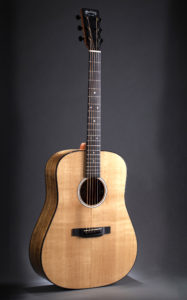 |
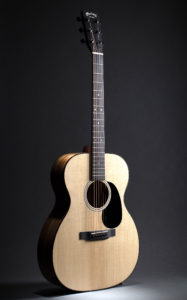 |
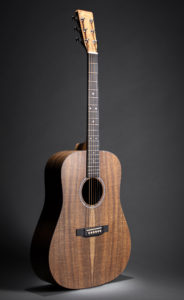 |
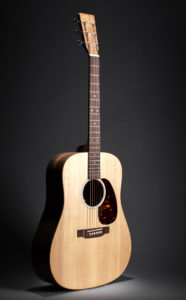 |
In the X Series there are now two dreadnought models, the D-X1E and D-X2E that have been upgraded by the use of real wood for the neck, and truly gorgeous looking koa was used to create the photographic image that makes the High Pressure Laminate look like top-shelf tonewood.
The D-X1E has a fretboard and bridge made of Richlite, while the D-X2E gets a wooden board and bridge made from katalox to go along with its solid Sitka spruce top.
The X and Road Series guitars come with Fishman MX electronics, with the Road Series guitars also having an onboard tuner included, placed just inside the sound hole.
You can learn more about these new Martin models HERE.
And coming soon! The new X Series Johnny Cash model!!
